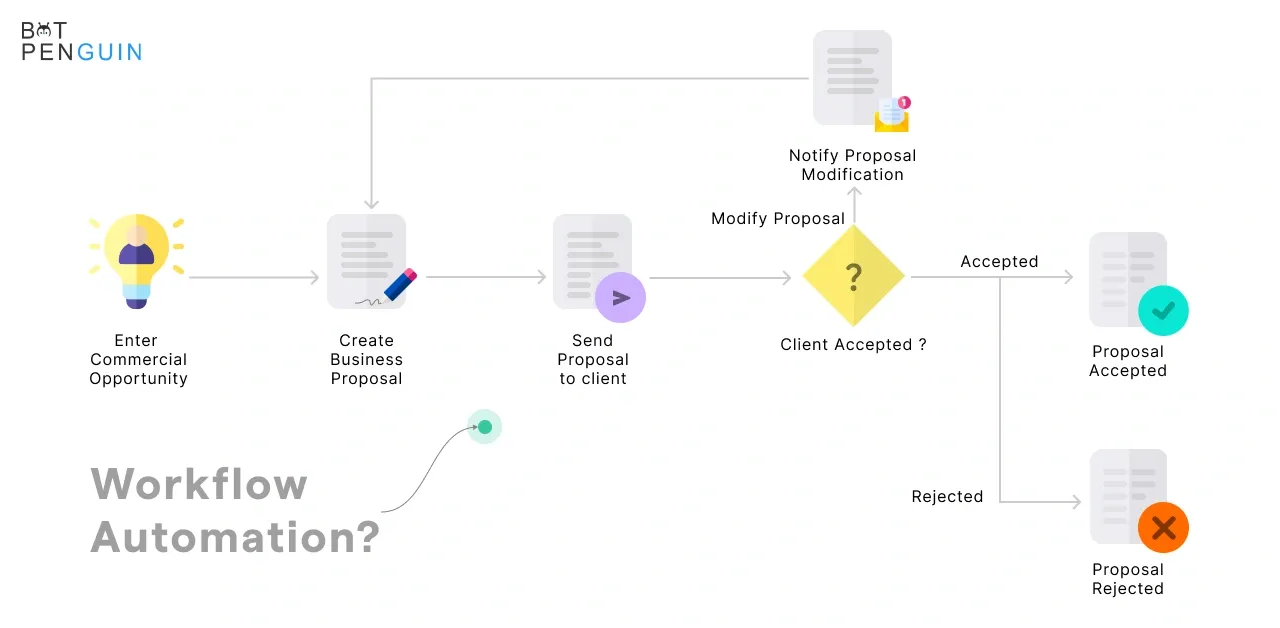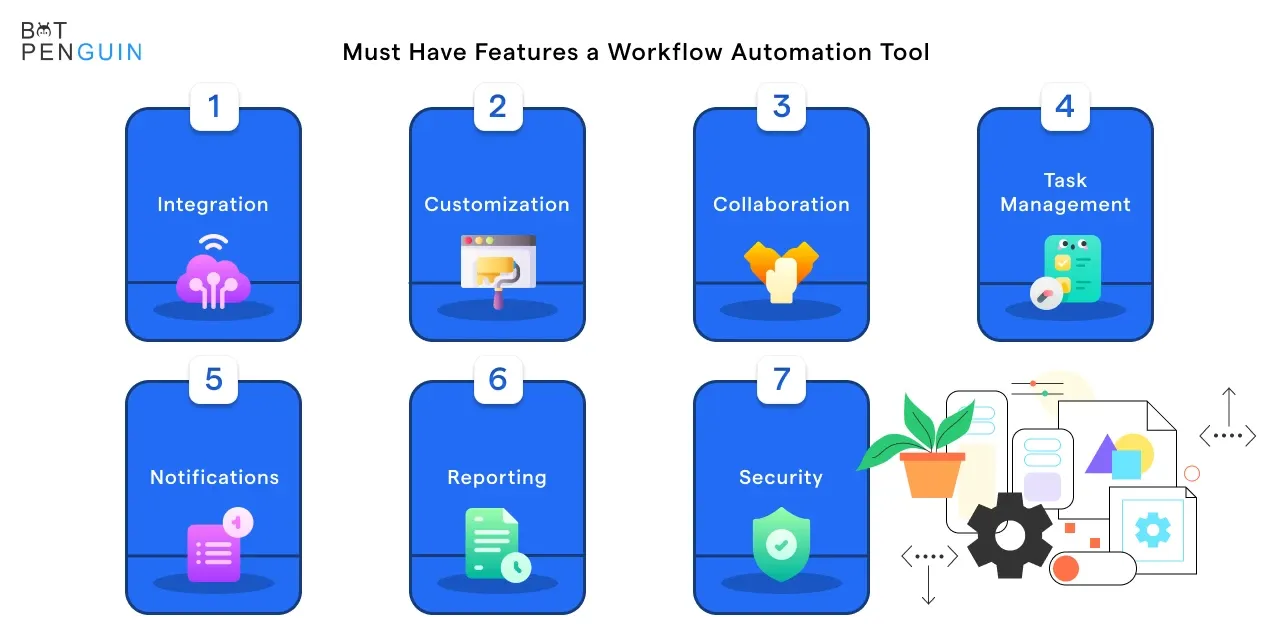Project managers are often overburdened. It is challenging for them to juggle responsibilities, deadlines, and resources.
Are you aware that repetitive chores that can be automated stymie 90% of your employees? Software for workflow automation is your best option to avoid this obstacle.
Fortunately, workflow automation technologies are available that simplify project management by automating some of the most irritating, time-consuming, needless, and repetitive business activities.
Process automation software employs rule-based logic to execute task sequences without human intervention. Once you've established the rules, the software will handle them.
In this blog, we'll explain workflow automation, how it may help you manage projects, and what tools you can use to get started. Thus, whether you're a new project manager or trying to improve your present process, keep reading for insights on workflow automation!
What is workflow automation?

Workflow automation is automating business processes, tasks, or workflows using technology to improve efficiency, productivity, and accuracy. It involves using software tools and technologies to automate previously manual, repetitive, or time-consuming tasks to streamline the workflow, reduce errors, and save time.
Workflow automation can be used in various business functions such as HR, marketing, customer service, finance, and operations. For example, in HR, workflow automation can automate the employee onboarding process, send reminders to new hires, and notify the relevant departments of further employee details. In finance, workflow automation can automate invoice processing, approvals, and payments.
Workflow automation tools typically use triggers, conditions, and actions to automate a series of steps in a process. Triggers are events that initiate the workflow, conditions are criteria that must be met for the workflow to continue, and actions are the steps that are executed when the conditions are met. Workflow automation solutions can help firms boost productivity, cut expenses, and enhance overall performance by automating specific procedures.
Advantages of workflow automation

There are numerous advantages to implementing workflow automation in a business, including the following:
Increased efficiency
By automating tasks, workflow automation tools can help businesses complete processes faster and more accurately. It can reduce the time and resources needed to complete tasks and improve productivity.
Cost savings
Automation can also save firms money by decreasing the need for manual labor, reducing errors and rework, and allowing employees to focus on higher-level activities.
Improved collaboration
Workflow automation tools can help teams collaborate more effectively by providing a centralized location for task management, document sharing, and communication. It can help teams work more efficiently and productively.
Increased accuracy
Automating tasks can reduce the risk of errors and ensure consistency in processes. It can help improve data accuracy and reduce the likelihood of mistakes or rework.
Improved customer service
Workflow automation tools can help businesses respond to customer inquiries faster, providing a better customer experience. Chatbots and other automation tools can handle routine inquiries, freeing staff to focus on more important issues.
Scalability
Workflow automation tools can help businesses scale their operations by automating repetitive tasks and allowing staff to focus on more strategic activities.
Workflow automation can provide businesses numerous benefits, from cost savings and improved efficiency to better collaboration and customer service. By automating routine tasks, businesses can free up staff to focus on higher-level activities while improving accuracy and reducing errors.
Popular workflow automation tools

1. BotPenguin
Botpenguin is an AI-powered chatbot-building platform that can automate workflows and improve customer engagement. With Botpenguin, businesses can create custom chatbots. It can be integrated with different messaging platforms such as Facebook Messenger, WhatsApp, and Slack. These chatbots can automate customer service, lead generation, and other business processes.
One of the critical features of Botpenguin is its visual chatbot builder, which allows businesses to create custom chatbots without any coding. The chatbot builder includes pre-built templates, drag-and-drop tools, and natural language processing (NLP) capabilities, making chatbots that understand and respond to customer inquiries easily.
Botpenguin also includes workflow automation features like lead qualification, appointment scheduling, and ticket management. For example, businesses can set up a chatbot to automatically qualify leads by asking questions and then routing the qualified leads to the appropriate sales team member. The chatbot can also schedule appointments and manage tickets by automatically assigning them to the relevant team member.
Overall, Botpenguin can be a powerful tool for automating workflows and improving customer engagement, particularly for businesses that want to leverage the power of chatbots without needing to have programming skills.
2. Zapier
Zapier is a popular workflow automation tool that connects different web applications and automates workflows. It provides an easy-to-use interface to set up automated workflows, called "Zaps," triggered by various actions, such as new email messages, completed forms, or recent social media posts.
3. Airtable
Airtable is a flexible and collaborative database tool that allows you to organize and automate workflows in one place. It provides a visual interface for creating custom workflows like project management, content management, or CRM. Airtable allows businesses to create custom forms, views, and fields and includes automation features such as automating data entry, sending reminders, and generating reports.
4. Trello
A visual collaborative tool called Trello makes it possible to plan tasks and projects using boards, lists, and cards. It provides a simple and intuitive interface to automate workflows, such as sending email notifications and moving cards between lists.
Trello also includes various collaboration features, such as assigning cards to team members, adding comments and attachments, and mentioning team members in comments. Trello integrates with various other tools, including Google Drive, Slack, and Jira, making it easy to incorporate into existing workflows.
Trello's simplicity and flexibility make it popular for many teams and projects, from small businesses to large enterprises. Whether managing a complex project, tracking personal tasks, or collaborating with a remote team, Trello provides a powerful and intuitive platform for getting work done.
5. Asana
Asana is a project management tool that provides a range of automation features, such as automatically assigning tasks, setting due dates, and sending notifications. It can be used for individual and team workflows and provides a visual interface for creating custom workflows, such as project management, task management, and team collaboration.
6. Microsoft Power Automate
Microsoft Power Automate, formerly Microsoft Flow, is a workflow automation tool for creating automated workflows between Microsoft applications and services. It provides a visual designer for creating workflows and includes a wide range of pre-built connectors.
7. Google Workspace
Google Workspace, formerly known as G Suite, provides a range of productivity tools that can be used to automate workflows. Google Sheets, for example, can be used to create custom scripts and automate tasks, while Google Forms can automate data collection and processing.
8. Automate.io
Automate.io is a workflow automation platform that allows you to create automated workflows between various web applications, such as Google Sheets, Salesforce, and Mailchimp. It provides a visual designer for creating workflows and includes a range of pre-built templates.
9. Workato
Workato is an enterprise-level automation platform that allows you to create complex workflows between various applications and services. It provides a range of pre-built connectors and templates and a visual designer for creating custom workflows.
10. UiPath
UiPath is a robotic process automation (RPA) platform that allows you to automate repetitive and time-consuming tasks using software robots. It provides a range of pre-built activities and a visual designer for creating custom workflows. It can be used for various industries like finance, healthcare, and manufacturing.
Suggested Reading:
Must have features of a Workflow Automation Tool

A workflow automation tool should have the following must-have features:
- Integration: The ability to integrate with other software systems and platforms is crucial. It allows for seamless data flow between systems, eliminating manual data entry and reducing errors.
- Customization: The ability to customize workflows based on specific business needs is essential. It ensures that the workflow automation tool can be tailored to meet the unique requirements of different departments or teams.
- Collaboration: Collaborating with others in real time is essential. It enables teams to work together efficiently and effectively, reducing delays and improving productivity.
- Task management: Managing and assigning tasks to team members is essential. It ensures that everyone knows what they need to do and when they need to do it.
- Notifications: The ability to receive notifications when tasks are completed or when there are workflow issues is essential. It ensures that teams can stay on top of their work and resolve problems quickly.
- Reporting: The ability to generate reports and analytics is essential. It enables teams to track progress, identify bottlenecks, and make data-driven decisions.
- Security: The ability to ensure data security and compliance is important. It ensures that sensitive information is protected and that the workflow automation tool meets industry-specific regulations.
Conclusion
In conclusion, workflow automation software will relieve you of tedious duties. You'll have enough time to devote to strategic business endeavors that demand your undivided attention. Choosing one workflow automation solution from the many available on the market can be challenging.
All business owners benefit from automated workflows, including independent contractors, solopreneurs, marketers, and managers. We advise you to compare them to your unique requirements and pick the option that best fits you.
Workflow automation is necessary to improve your work-life balance. You will have more time to spend with your family and friends or concentrate on projects that are more essential to you by making time for them. By automating your job, you can guarantee that tasks are always completed quickly and precisely.



